Michigan
Law Passed: 1915 • Joined NCARB: 1921 • Region 4—Mid-Central (1965)
The Components of Licensure
Education
1933: No education is required for licensure.
1977: An acceptable Bachelor’s degree is required, updated to a four-year, pre-professional degree in architecture in 1980.
1984: A degree from a NAAB-accredited program is required.
Experience
1990: Michigan requires the IDP.
2017: Michigan updates the requirement to the AXP.
Examination
1933: Applicants must pass a 29-hour exam administered by the board, reduced to 28 hours in 1945.
1958: Michigan models its examination after NCARB’s syllabus, updating to NCARB’s national exams in 1965.
1983: The ARE is required.
Noteworthy
Many famous architects shaped Michigan’s built environment, including Elijah Meyers, Daniel Hudson Burnham, George Mason, Louis Kamper, Frank Lloyd Wright, Albert Kahn, Eliel Saarinen, Emily Butterfield, and more.
Michigan architect Emil Lorch spearheaded the establishment of the Michigan Board of Architects, and was appointed the first board president in 1916. He later went on to help found NCARB in 1919, serving as the organization’s first president, and served as the president of ACSA.
Michigan Board Member Thomas Sedgewick worked to establish reciprocity agreements during his term as NCARB President.
In October 2013, Michigan began requiring continuing education for renewal.
Notable People
NCARB Presidents
1920-22: Emil Lorch, FAIA (Ann Arbor)
1929: George D. Mason, FAIA (Detroit)
1973: Thomas J. Sedgewick, FAIA (Flint)
Additional Member of the NCARB Board of Directors
2001-02: Daniel A. Redstone, FAIA (Southfield)
2018-present: Kenneth R. Van Tine (Brighton)
First President/Chairman:
1915: Emil Lorch
First License Issued
1916: George D. Mason, FAIA (Detroit)


